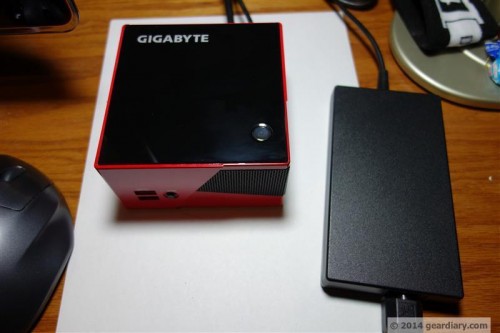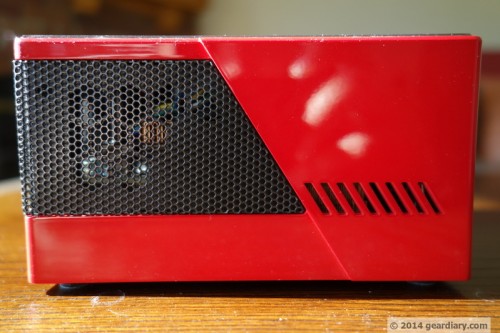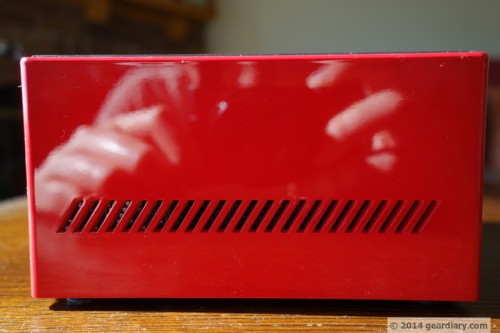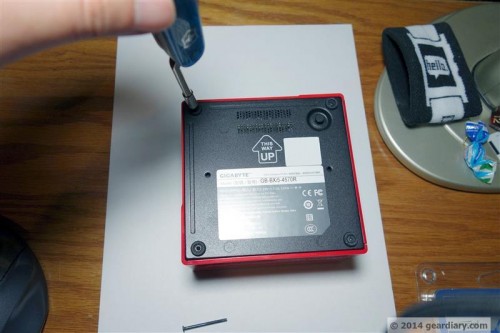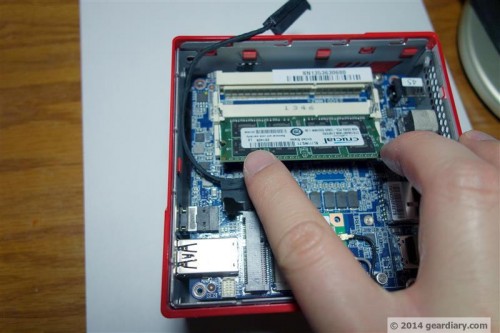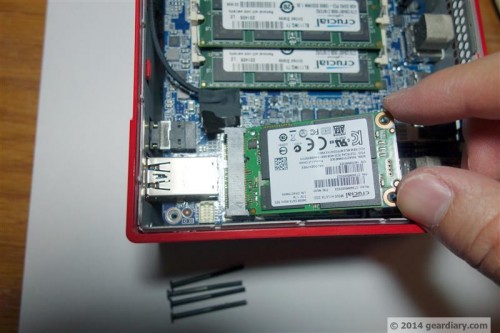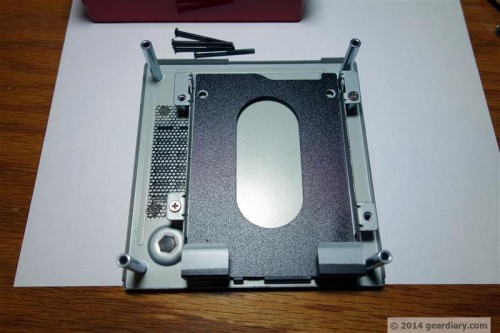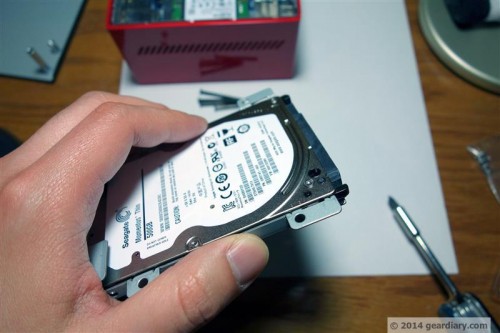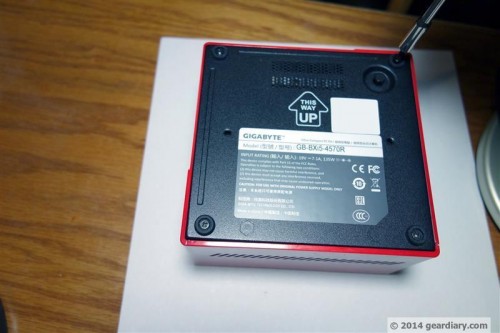Lately consumers have been shunning the traditional desktop PC for laptops. Today’s mobile processors are powerful enough to meet the average user’s needs, and now power-sipping mobile chips are regularly showing up in PCs sold by companies such as Lenovo, Apple, and Dell. Is there still room for desktop CPUs in computers you won’t hide under the table?
Gigabyte Brix Pro, When You Need More Power
Two years ago Intel joined the mobile-chip-on-your-immovable-desk movement with the entry of their Next Unit of Computing (NUC) products. The Haswell-based, third generation NUCs remain smaller than most sandwiches, yet they still manage to contain a Core i5 CPU, Intel’s latest Iris graphics chipset, and all the full-sized ports you would expect on a PC in 2014. Open all the YouTube videos, multi-layer Photoshop files, and Skype HD sessions that you want; a NUC will keep on trucking. Even the lower end models will still have enough oomph to power your home theater… or your Spiderbot of Doom.
On the other hand, what if you need more power? What if you want to edit and encode video, or play recent games like Bioshock Infinite and Tomb Raider? That’s where the Gigabyte Brix Pro comes into play. Packing a full-fat quad-core Core i5 or Core i7 desktop CPU and Intel’s top-of-the-line Iris Pro graphics chipset, ounce for ounce the Brix Pro is one of the most powerful PCs that you can put on your desk—or in a media center, or on a bookshelf, or on a windowsill*—today.
*Neither I nor Gear Diary is responsible for any damage or bodily harm incurred if your PC falls off a windowsill. Please don’t put PCs there.
It’s important to note that the Brix Pro is not a complete PC (this is true of all NUCs), so you won’t be able to use it right out of the box. Fortunately, Gigabyte has already done most of the fiddly work for you, and they were even nice enough to preinstall a combination 802.11ac Wi-Fi/Bluetooth 4.0 module. All you need to add are memory, storage, and an operating system. An experienced system builder can put the hardware together in less than ten minutes. However, even a novice shouldn’t need more than twenty. In fact, I can show you how to do so in four easy steps, and the only tool you’ll need is a Phillips screwdriver.
But before we start taking it apart, let’s take a quick tour around the Brix Pro.
All you’ll find on top of the Brix Pro is a single piece of glass, a LED-lit power button, and the Gigabyte name. The Brix Pro is handsome unit overall, but I wish they’d stuck with more metal (blazing red on the i5 model; a more pedestrian glossy black for the i7) for the top: the glass ends up being a complete fingerprint and dust magnet, especially around the power button. You can also see in this photo that the Brix Pro would be a bit tall for a sandwich. Upgrading the “bread” on the NUC “sandwich” to Texas toast provides additional room for cooling the more powerful CPU, as well as support for a traditional hard drive.
Up front we have two USB 3.0 ports, a headphone jack, and a somewhat gaudy vent. The headphone jack also doubles as an optical line-out for home theater purposes. It would be aesthetically better to have a line-out cable coming out of the back instead, but they were understandably tight on space. And most folks would probably…
…simply use audio via HDMI anyway. But I’m getting ahead of myself. From left to right, we have a power jack, a full-size HDMI port, mini DisplayPort, gigabit Ethernet port, and another two USB 3.0 ports. These are sandwiched by two comparatively large vents and the ubiquitous Kensington slot.
A brief detour: Gigabyte managed to keep the size down by leaving the power supply out, in the form of a power brick that any laptop user would be familiar with and contemptuous of. It’s only a little larger than a regular laptop power supply, but next to the Brix Pro it’s slightly comical.
The sides are more blazing red—it’s really quite nice—and more vents.
Also in the box: a driver disk, a VESA mounting panel, and a manual. It’s a bit of a spartan package, but it’s hard to say what else they could have included. Fruit-shaped stickers, perhaps?
Gigabyte Brix Pro Assembly
Time to put this together. Begin by flipping the Brix Pro over and undoing each of the four screws, located in the four feet; then, lift the lid using the handy knob in the upper-right corner.
Slot in your memory at an angle as shown; then press down to lock in place. The Brix Pro takes up to two 204-pin SO-DIMM DDR3 1.35V modules for a total of 16 GB. At current prices, the sweet spot appears to be two 4 GB modules for a total of 8 GB. At this point installing anything less than 4 GB total (whether as one or two modules) would be silly in terms of both cost and user experience.
Slot in an mSATA solid-state disk at an angle. Then, insert and tighten the provided screw to lock it down. Consider a minimum of 120 GB here; I managed to snag a Crucial M500 240 GB module on sale.
Optionally: if you need more than 240 GB but understandably balk at forking over hundreds of dollars for more space, take advantage of the drive tray on the underside of the lid. It accepts all standard 2.5” hard drives and solid-state disks. You can either install a drive as a secondary storage unit, or skip the mSATA disk entirely. Note that having an SSD (even if only in the form of a hybrid drive) will boost the PC’s performance.
Remove the tray from the lid, install your drive, and reattach the tray to the lid. Then plug in the black SATA cable shown in the first innards photo.
All that’s left to do is to put the lid back on the Brix Pro (with or without hard drive) and screw it shut. Simple, wasn’t it?
At this point you have a couple of choices regarding the operating system: what to install, and how to install it. You can certainly install a Linux distro on it, and the Brix Pro was shown off at CES 2014 by Valve CEO Gabe Newell as a SteamOS-powered game console. Alternatively, one could use it as a foundation for a hackintosh, running OS X. I ended up going the more traditional (read: Gigabyte provides support for) route of installing Windows, albeit the slightly less traditional Windows 8.1. Gigabyte provides drivers for Windows 7 and 8 as well.
If it isn’t already apparent, it is physically impossible to fit an optical drive into the Brix Pro. You can install Windows via disc after purchasing an external DVD drive for $30 or less. Or, you can make a USB boot drive. While the DVD drive might come in handy for installing the drivers from the provided disc, you can always download them from Gigabyte’s website. One last quick visit to Ninite for commonly installed software, and you’re done!
The Gigabyte Brix Pro In Use
It’s to Gigabyte’s credit that I’m finding it difficult to say anything besides, “Yep, it’s a PC.” Unlike a cell phone, there aren’t any displays to analyze or UI skins to deal with. Unlike a laptop or tablet, battery life isn’t a consideration. Since it comes as a blank slate, there’s no need to worry about manufacturer or carrier bloat. And without comparable PCs on hand, benchmark numbers are pretty meaningless. But that a gimmicky-looking PC can perform indistinguishably from or better than its bigger-boned brethren**—that’s probably one of the higher compliments I can give it. Plus, it boots faster than my iPhone. Remember the days when a cell phone powered up more quickly than a computer?
**Two of its predecessors can be seen in the photo above; the third one couldn’t fit in the frame—or on the table.
I can say that Borderlands 2 and Tomb Raider play on it just fine, though the latter needs the settings turned down a bit to achieve 30 frames per second or more (and forget about TressFX). It should be no surprise that Source-based games such as Left 4 Dead 2 and Counter-Strike: Global Offensive aren’t much of a match at all, even at high settings. With Intel’s latest drivers, Titanfall handles well at low-to-medium settings. And once the topic turns to lauded indie games such as Mark of the Ninja, Gone Home, and Thomas Was Alone—a system like this is overkill, really. Other applications? Well, I’m willing to entertain requests regarding performance tests of software or computing tasks… as long as I’m provided with a copy of the necessary program(s), natch.
The only real knock against the Gigabyte Brix Pro I can come up with is that four USB ports are not quite enough. Like the 2013 Mac Pro***, there is no real internal expansion capability to speak of. Currently plugged in are a data storage array (which will be reviewed shortly), a Logitech Unifying Receiver, and a printer. This means I have to either play musical chairs with my Lightning cable, memory card reader, etc or resort to a hub. Intel’s Z87 chipset can accommodate up to six USB 3.0 ports, so it’s a shame that Gigabyte was unable to take advantage of that support.
***Probably the first and last time that the words “like the 2013 Mac Pro” will ever be used in reference to a Brix Pro.
Regarding the 4770R variant of the Brix Pro, there are a number of reviews that complain about fan noise even at low processing loads. Conversely, I have yet to hear any negative remarks about the fan on the 4570R Brix Pro. As expected, the fans on both models get pretty loud when stressed. Aside from that, there are three differences with the 4770R: a 20% increase in CPU clock speed, a black chassis, and a $150 lighter wallet. Choose carefully.
The Brix Pro is in a somewhat unique position for custom/semi-custom builds where value is concerned. Building a desktop can be a
fun way to learn more about computers. PC enthusiasts like the fact that they get to choose exactly the components they want. And putting together your own PC gives you the chance to have something unique, especially if you’re willing to enter the wild world of case modifications. What it typically isn’t is a money-saving opportunity. However, manufacturers put a premium on space-efficient computers, particularly with their more powerful models. So if you’re dead set on something Mac mini-like in both space and cost, then it’s hard—if not impossible—to beat the Brix Pro performance-wise. The 4570R regularly sells for less than retail price, and the total price of the build shown here was just under $750; that includes a copy of Windows.
To close out this post, here is an obligatory gallery of things that look disproportionately large next to a Gigabyte Brix Pro:
MSRP: $529
What I Like: Phenomenal computing powers, itty-bitty living space; whisper quiet during normal usage; snazzy looking chassis.
What Needs Improvement: Could use more USB ports; glass top should be done away with, or perhaps replaced entirely with a larger and quieter shielded fan.
Source: The Gigabyte Brix Pro was a personal purchase





